
9 minute read
Managing for quality in silviculture
Jez Ralph of Timber Strategies encourages readers to think wood science when growing trees for timber.
As we move towards more complex silvicultural systems (at least in many lowland areas) where we take more notice of individual trees it gives us a chance to consider quality as well as quantity in our standing resource.
Continuous cover forestry (CCF), agroforestry, urban forestry and even small farm woodlands present huge opportunities to expand what we think of as “conventional” forestry. These systems potentially enable us to look more closely at what we have. With increased management time comes increased need to garner as much value from individual stems as possible. This won’t likely come from forcing sales into volume/commodity markets but will come from managing for quality. It’s not for everyone, it isn’t the answer for all forestry, but it is a potentially large and generally untapped area of development.
To do this we, as an industry, as individual owners and managers, need to understand quality by stepping outside the forest gate and looking back in. From the point of view of timber users, R&D scientists and future generations, what does quality mean, and how do we adapt our silviculture to suit it?
Macro scale quality
Understanding the anatomy of a tree and the anatomy of useable timber helps to understand how silviculture can make or break the end quality and value of timber. As an example, let’s take the proportion of juvenile core to heartwood in a tree. Juvenile core is the soft, bendy, early wood that allows saplings and tree tips to respond to environmental stress such as wind or snow loading. It works extremely well up to a certain point at which time the tree needs to become a stiffer solid column. It is the heartwood the tree generates to become stiff that is of interest to us, that will maximise the good, gradeable timber within the tree. Ideally we want to minimise juvenile core and maximise heartwood and we can go some way to doing this through how we plant and how we thin to get stems over the juvenile core stage as quickly as possible.
Whilst we understand this, new silvicultural systems allow us the intimacy of knowledge in a forest to see where this is going to work, perhaps where it isn’t. New extreme examples, such the Myawaki Method of planting that has roots (sorry!) in environmental urban forestry, maybe deserve more attention as a silvicultural method for quality timber?
Then let’s consider knottiness. Most timber users, especially for structural purposes, hate knots. Knot-free timber will always be at a premium, if nothing else it reduces the need for cross-cutting and finger jointing at timber-engineering plants. It will also, along with ring-width, significantly increase the grade timber could attain. Reducing knottiness is a matter of species selection, genetics, planting spacing and thinning. It’s complex but can be significantly enhanced by the oh-so out-of-fashion and oh-so rewarding practice of high-pruning. To carry a pruning saw on a walk-through small woodland or CCF stand is no great burden but has the potential to create knot free timber in selected trees from an early age (note: bad pruning can be as counter-productive as good-pruning can be productive, think of it as a craft worth learning).
I could go on and on about increasing target diameters but let’s leave that here hanging for a big debate sometime.
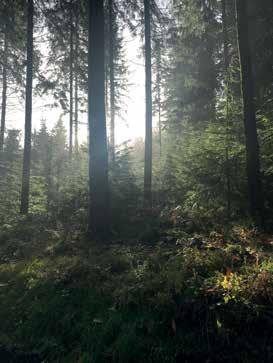
Micro Scale Quality
On a macro scale we can see the effects our silvicultural interventions have but what happens on a micro scale is more difficult to see and understand but no less important. The work of many scientists, not least at the Centre for Timber Engineering and other UK research groups, is enabling us to match factors such as density, durability and stiffness through micro-fibril angle to how we grow trees.
Again, new systems such as small coupe fellings or small-woodland management may offer the chance to experiment without pushing the whole forest into a particular system for a desired outcome. They offset risk and may offer high reward. Stiffness is a good example of this. If we can grow stiffer timber we can increase the potential structural grade a tree can reach, enhancing the value. As with the macro scale, species selection and environment helps but we can bring

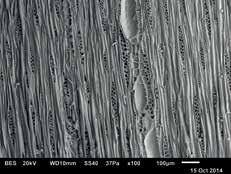
our thinning practices to bear as well. A study on Douglas fir in England showed that we get greater stiffness the further away from the juvenile core we go. Growing what has conventionally been considered “oversized” gives us a greater volume of timber of better quality.
The same is true of density, we can alter thinning practices to influence density but should also be aware that the anatomy of a tree changes within itself. Knowing how the lower sawlog will likely differ in density or stiffness to higher-up sawlogs could help us breakout stacks for road-side sales in a more considered way.
As we move to a position of timber once again potentially becoming the new material of choice for society we should be able to match silviculture to user needs not just for construction timber but also for bioenergy and the great untapped potential of bio-resins and chemicals.
Having said all of this it’s not just the forestry sector that can move to a more nuanced approach to silviculture. Those using wood also need to move to a more nuanced approach material sourcing. In my mind at least the primary objective in forestry has to move from material supply in this rotation to ensuring healthy forests for future generations and rotations. Our understanding of wood properties may help us move away from monocultural systems but also allow users to get the properties they need in a material without a focus on a particular species or a particular age class. This won’t be appropriate everywhere but it is certainly true that large areas and woodlands we conventionally think of as non-timber producing could benefit from both growers and users understanding wod properties better.
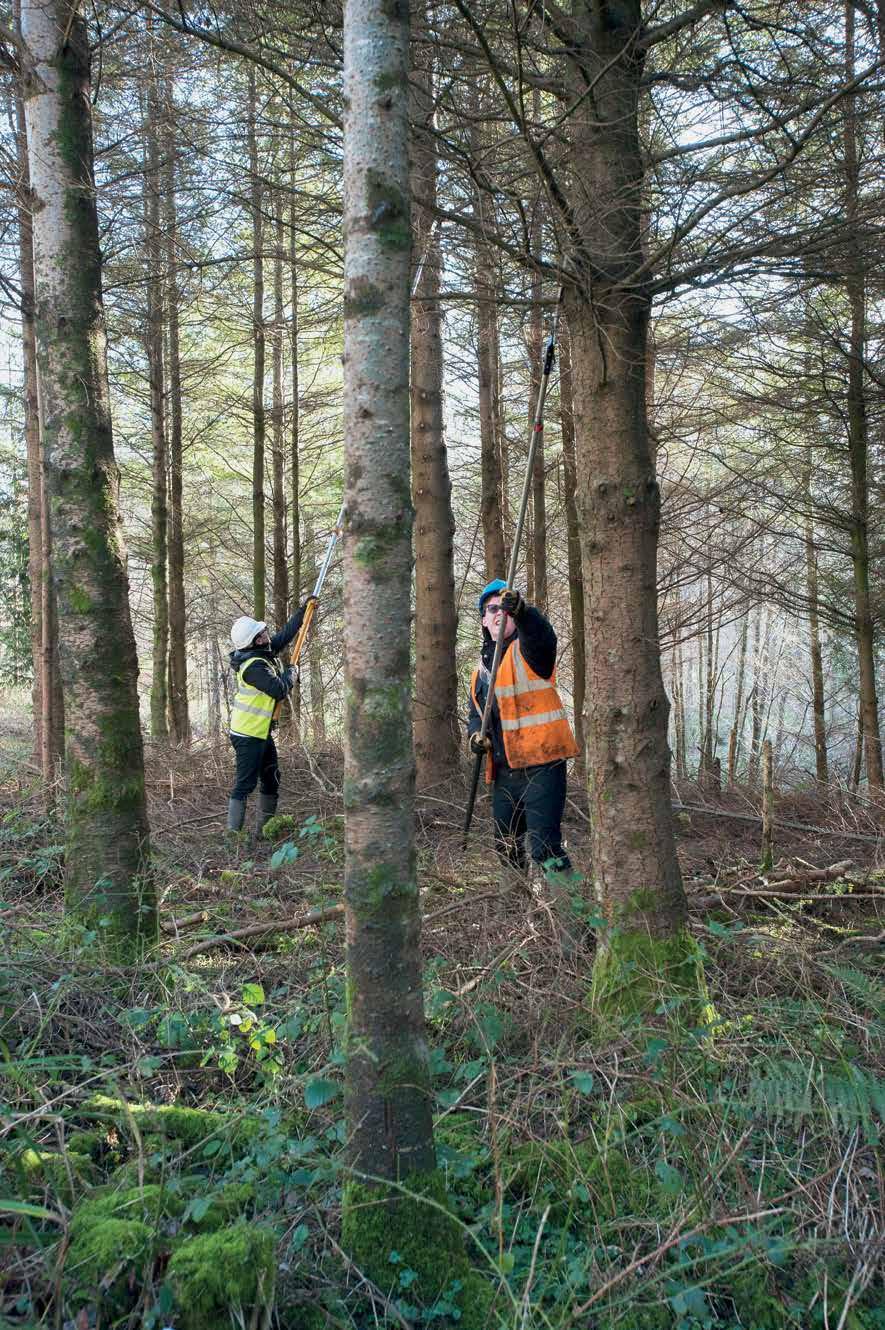
Photo credit: Valerie Bennet, High Pruning at Hooke Park
by Home Forestry LLP© Suppliers of new and used by Home Forestry LLP© Suppliers of new and used
Suppliers of new and used forestry, firewood and fencing machinery forestry machinery Suppliers of new and used forestry, firewood and fencing machinery forestry machinery
New Defra grant available for mini-forwarders
NEW ALSTOR 840 PRO COMBI FORWARDER • Hydro-static 8 wHeel drive - 2 speed witH incHing • parker flow sHaring Hydraulic mini-levers • 5m palms crane full rops, fops, ops Alstor 840 Pro with cab witH air-con Syketec ST50 Bambi • 29Hp kubota 3 Stroke Harvesting head cylinder diesel
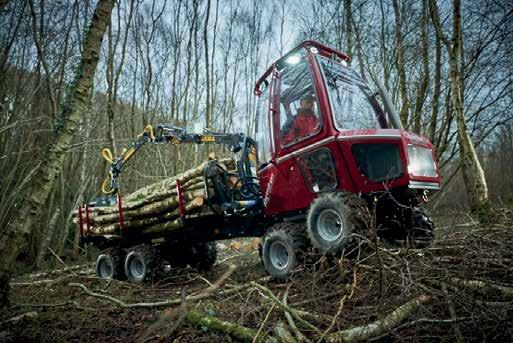
NEW • ALSTOR 840 PRO COMBI FORWARDER Range of models available • •Hydro-static 8 wHeel Stoke or Combi with drive - 2 speedwitH feed wheels incHing • CAN-MID length & diameter controls • • parkerflowsHaring Suitable for smaller base units Hydraulicmini-levers • 5m palmscrane full rops, fops, ops cabwitHair-con • 29Hp kubota 3 cylinderdiesel
• Range of models available • Stoke or Combi with feed wheels • CAN-MID length & diameter controls • Suitable for smaller base units
Alstor 840 Pro with Syketec ST50 Bambi Stroke Harvesting head
Alstor miniforwarders and harvesters Unrivalled in the Terrain
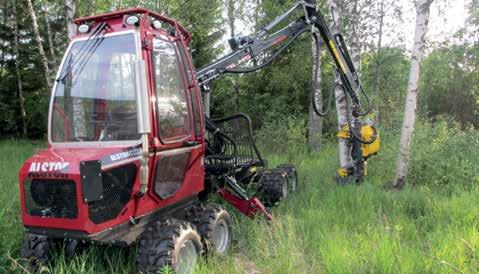
Contact us for more information
UK & Ireland Alstor 8x8 Agent UK & Ireland Alstor 8x8 Agent Rabaud Forestry & Agricultural Machinery Rabaud Forestry & Agricultural Machinery England and Wales Syketec dealer England and Wales Syketec dealer WORKBOX WORKBOX
Contact us for more information
tapio 160 stroketapio 160 stroke Harvester Head readyT. 01746 718 456 • M. 07966 365 157 HarvesterHeadreadyT.01746 718 456 • M. 07966 365 157 2.4 tonne witH 3 tonne••• E. nathan@homeforestry.co.uk •2.4 tonnewitH 3 tonne• E. nathan@homeforestry.co.uk • load capacity Home Forestry llp, Willowdene Farm, loadcapacity Home Forestry llp, Willowdene Farm, low ground pressure• Chorley, Bridgnorth, Shropshire, WV16 6PP. lowgroundpressure• Chorley, Bridgnorth, Shropshire, WV16 6PP.
Euroforest A5 landscape Ash Ad.qxp_Layout 1 13/03/2019 09:20 Page 1 • Suppliers of new and used forestry HigH outputs• Suppliers of new and used forestry HigH outputs firewood and fencing machinery unrivalled in sensitive•• firewood and fencing machinery unrivalledinsensitive and difficult sitesanddifficultsites ManagingContact us for a demo at our Forestry Yard Contact us for a demo at our Forestry Yard Ash DiebackAlstor mini forwarders • Rabaud Firewood processors • Saw benches • Kindling machines • Chain winches • Farma cranes and trailers • Log peelers & pointers • Log splitters 14-80 tonnes • Cone splitters • Cleaving splitters • Grader blades Rabaud firewood processors • Mulchers • Saw benches • Kindling machines • Chain winches • Farma cranes and trailers • Log peelers & pointers • Log splitters 1 4-80 tonnes • Cone splitters • Cleaving splitters • Grader blades Alstor mini forwarders • Rabaud Firewood processors • Saw benches • Kindling machines • Chain winches • Farma cranes and trailers • Log peelers & pointers • Log splitters 14-80 tonnes • Cone splitters • Cleaving splitters • Grader blades Rabaud firewood processors • Mulchers • Saw benches • Kindling machines • Chain winches • Farma cranes and trailers • Log peelers & pointers • Log splitters 1 4-80 tonnes • Cone splitters • Cleaving splitters • Grader blades

■ Ash Die Back (Chalara) is now present throughout the UK. ■ Sadly expectation is for up to 97% loss of ash trees. ■ Ash is widespread in woodlands and roadside edges. ■ Are you managing your liability, particulalrly in respect of falling trees around footpaths and highways? ■ Secondary factors, such as honey fungus, can cause rapid decay. Decide NOW, before the timber value tumbles, or the removal of increasingly unstable trees becomes more dangerous and costly.New Rabaud Xylotrail forwarding trailers New Rabaud Xylotrail forwarding trailers Using specialised, cost-effective machinery and expert teams, supported by professional management, Euroforest will turn your dying woodland into a sustainable asset. T. 01746 718456 M. 07966 365157 www.homeforestry.co.uk E. nathan@homeforestry.co.uk Home Forestry llp, Willowdene Farm, Chorley, Bridgnorth, Shropshire WV16 6PP T. 01746 718456 M. 07966 365157 www.homeforestry.co.uk E. nathan@homeforestry.co.uk Home Forestry llp, Willowdene Farm, Chorley, Bridgnorth, Shropshire, WV16 6PP. T. 01746 718456 M. 07966 365157 www.homeforestry.co.uk E. nathan@homeforestry.co.uk Home Forestry llp, Willowdene Farm, Chorley, Bridgnorth, Shropshire WV16 6PP T. 01746 718456 M. 07966 365157 www.homeforestry.co.uk E. nathan@homeforestry.co.uk Home Forestry llp, Willowdene Farm, Chorley, Bridgnorth, Shropshire, WV16 6PP.

sustainable excellence

For further info visit www.euroforest.co.uk and speak to your local Area Manager, or simply call 01228 217517.
FSC® C010890










